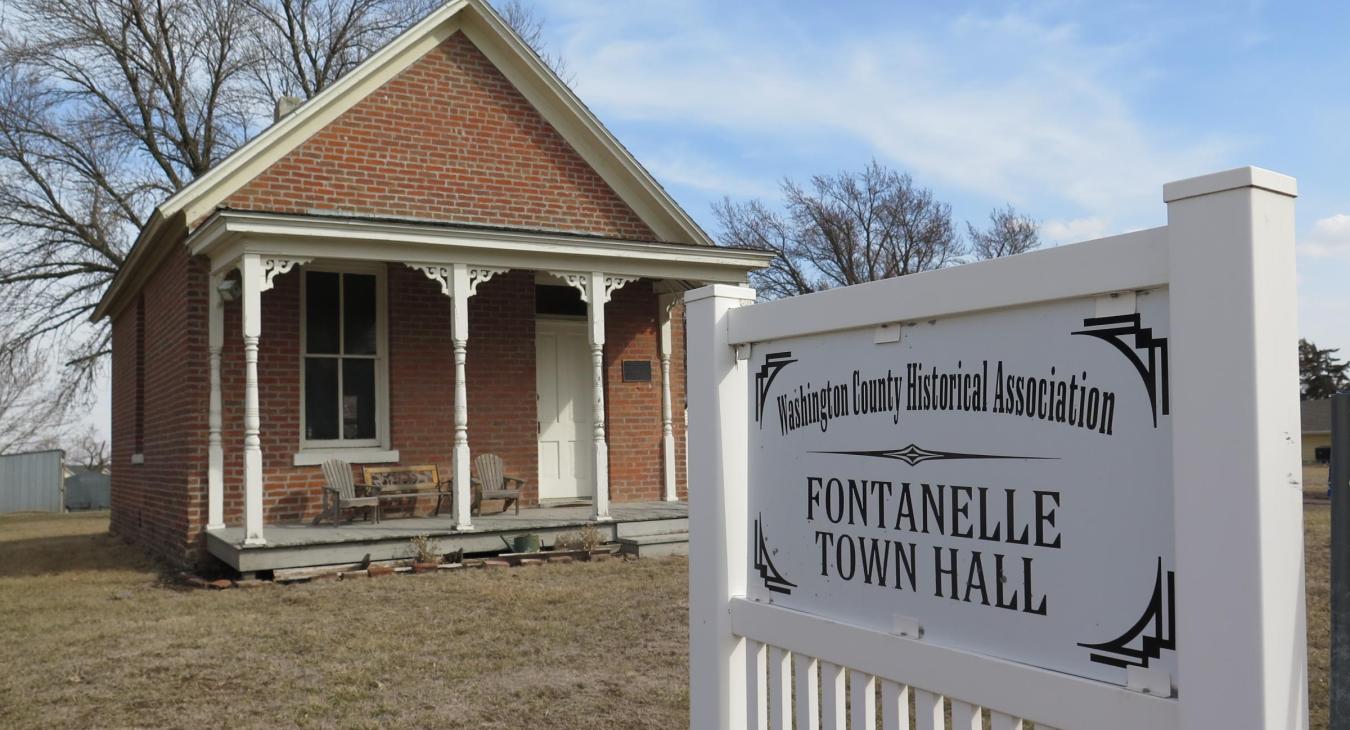By LaRayne Topp
One conversation with an Indian leader. One letter on a rubber stamp. One twist in the route of a railroad. One switch of a county line. One vote. All of these seemingly insignificant “ones,” have fashioned the history of Fontanelle, Nebraska. In the running to be the capital of the new Nebraska Territory, Fontanelle today rests as a quiet and unincorporated village on the banks of the Elkhorn River.
It also remains a village of firsts: the first seat of Dodge County; the first site of Nebraska University; the first school west of the Missouri River to offer college courses; its post office among the first in the territory.
Fontanelle’s story begins in 1854 when the United States Congress passed the Kansas-Nebraska Act, claiming Indian land for the Nebraska Territory, encompassing portions of what is known today as Nebraska, Wyoming, the Dakotas, Colorado and Montana.
A month after this bill passed, a joint stock company of German immigrants, primarily from Quincy, Illinois, formed the Quincy Colony Company, desirous of establishing homes in this new territory. On an 1855 visit, they ferried across the river at Omaha City, meeting Logan Fontenelle, a leader of the Omaha nation. He guided them to an Elkhorn River bluff about forty miles northwest of Omaha City, and from this overlook showed them a promising grassy plateau below.
With the mistaken idea that the river was navigable and could be used as a means of transportation, the Colony agreed on the sum of $100 to purchase the 20-square-mile property. Mary Cole, a steamboat bringing up early families, struck a snag in the river below Omaha City and sank, proving this idea might be folly.
The Colony named the settlement Fontenelle in honor of the Omaha leader. Years later, a worn-out rubber stamp designed to approve village paperwork was replaced by a manufacturer. It came with an “a” instead of an “e” and the misnomer, Fontanelle, stuck.
Early years were difficult for the colony. Snow blew in through the cracks of primitive log houses, fronted by wagons and farm implements, with cows, pigs and chickens wandering the streets, wrote early inhabitant Perla Evans Houston.
Fontanelle homes were lighted by tallow dips, and even those were scarce. “One candle—we felt—was a necessity,” Houston wrote. “Two, an extravagance; but when three were lighted, neighbors gathered for a party.”
In addition, the villagers were plagued with prowling wolves, howling blizzards, fierce prairie fires, and violent summer electrical storms.
Streets were named after the country’s thirteen colonies, and four bachelors built the first log cabin in the community, for the Lutheran congregation’s services.
One of these bachelors was Henry Sprick, who returned to Quincy in 1857 to bring back Sophia, his bride. He became a successful farmer and businessman, purchasing land from those who left, discouraged by the hardships of such a new country. Eventually he came to own 3,000 acres of prime Nebraska farmland, and served in the Nebraska Legislature for three sessions, traveling on the train from Nickerson to Lincoln.
Sprick’s obituary stated they were establishing a town “which at that time had its chief existence on paper and in the minds of the colonists who had planned to make it a great city, and if possible the capital of the state soon to be created… vying with Omaha in importance; and at the first meeting of the territorial legislature it only lacked one vote of becoming the capital of the territory.”
A reroute of the Burlington Northern to the other side of the river changed everything.
Plattsmouth, Brownville, Omaha City and Fontanelle were among those favored to become the first Territorial Capital. An act of the Legislature approved Omaha City on January 30, 1855. However, blueprints had already been drawn up for the layout of the Fontanelle capital and are on display at the Washington County Museum at nearby Fort Calhoun.
A section from Andreas’ History of the State of Nebraska, Washington County, explains it this way: “…Fontenelle entered the lists as a contestant for the prize of the Territorial Capital, but failed after having exhausted every expedient known to the politics and diplomacy of those times. She, however, was incorporated and became a city, by legislative enactment, on March 14, 1855. She also succeeded in securing a charter for a college, named Nebraska University, to be located there; so she was not altogether destitute of consolation.”
In 1860, the western boundary of Washington County was redefined, removing Fontanelle from its status as county seat of Dodge County. According to the Andreas’ History, “she lost her bright future metropolitan prospects.”
Once the settlement was no longer the county seat, plus lost its bid for territorial capital, the town’s university, built in 1856, was in a precarious position as well.
The first building of Fontanelle University, also known as Nebraska University, was a two-story structure fashioned entirely from local cottonwood lumber. This four-year-college became a center of activities for the town, the meeting place for Good Templars Lodge Lyceum and Debating Society, a temperance movement, plus the Congregational Church.
A Professor Burt was the first principal, enjoying a salary of $40 a month, right up until the first college building burned in December of 1865. Rumor says the fire was ignited by a chemistry experiment gone bad.
Burt resigned and the college was rebuilt. Three prosperous years followed, prompted by strict rules for attendance: no use of tobacco, games of chance, profane language or intoxicating drinks. Students were required to attend worship on the Sabbath, and all pupils were to be engaged in study or recitation between designated hours, retiring to bed at 10:00 each evening.
Plans were made for expansion; however, in 1871 a windstorm hit. By 1872, the college was moved to Crete and became Doane College. Today, the college’s initial location is indicated with a large rock.
Henry Sprick’s great-granddaughter is familiar with the rock. Eleanor Harmon’s parents first met at the rock’s dedication. Now in her 80s, when Harmon was a girl, the town was buzzing, with a blacksmith shop, a brickyard, a school for grades Kindergarten through 10th, and a general store where folks picked up their mail and purchased everything from ice cream and Fig Newtons to kitchen items. It came with a dance hall on the second story.
Eventually the school closed, as well as the general store and brickyard. The high school is now a private home. Fontanelle never became the territorial capital and isn’t a county seat or large university town. Instead, it’s a small, safe and close-knit community, where a family can still come to church on a Sunday morning. Its tidy, well-kept homes are nestled in on streets named after the country’s first 13 states, right alongside the original Village Office, proudly listed in the National Register of Historic Places.
Exactly the kind of town for which the original settlers of Fontanelle were hoping.


